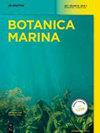A new species of Craspedostauros (Bacillariophyceae) from the west coast of Sweden, with taxonomic and ecological notes on Craspedostauros laevissimus
IF 1.4
4区 生物学
Q2 MARINE & FRESHWATER BIOLOGY
引用次数: 0
Abstract
Since its separation from瑞典西海岸 Craspedostauros(Bacillariophyceae)的一个新物种,以及 Craspedostauros laevissimus 的分类学和生态学说明
自 1999 年从 Stauroneis 中分离出来以来,在不同的生境和地理位置发现了几个 Craspedostauros 的新物种,为该属的研究增添了形态学和系统发生学数据。在对瑞典西海岸和东海岸的滨海硅藻进行调查时,发现了两个附生石柱的物种,并根据该属的特征(包括石柱比中央区域狭窄和具有肋状窠片)将其归入 Craspedostauros。其中一个物种被描述为科学界的新物种:Craspedostauros lateralis sp.nov.,另一个物种的身份不确定,但与 C. laevissimus 具有形态上的相似性。Caspedostauros lateralis 是一种海洋附生物种,发现于瑞典哥德堡市附近的西海岸。根据光镜和电子显微镜,详细描述了这些物种的形态和超微结构特征,并讨论了与同属物种的区别特征比较。文中还提供了一些生态学数据以及寄主大型植物上相关物种的出现情况。
本文章由计算机程序翻译,如有差异,请以英文原文为准。
求助全文
约1分钟内获得全文
求助全文
来源期刊

Botanica Marina
生物-海洋与淡水生物学
CiteScore
4.10
自引率
4.50%
发文量
43
期刊介绍:
Botanica Marina publishes high-quality contributions from all of the disciplines of marine botany at all levels of biological organisation from subcellular to ecosystem: chemistry and applications, genomics, physiology and ecology, phylogeny and biogeography. Research involving global or interdisciplinary interest is especially welcome. Applied science papers are appreciated, particularly when they illustrate the application of emerging conceptual issues or promote developing technologies. The journal invites state-of-the art reviews dealing with recent developments in marine botany.
 求助内容:
求助内容: 应助结果提醒方式:
应助结果提醒方式:


